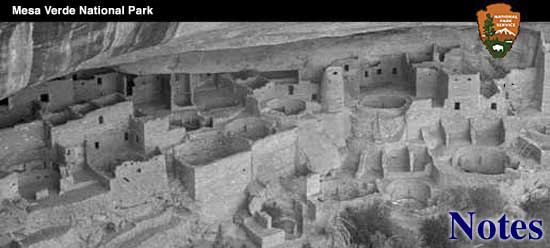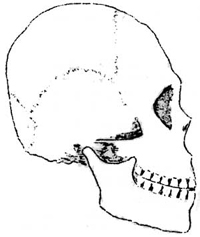

|

Present-day Americans who have the opportunity to visit Mesa Verde National Park are both pleased and impressed by the grandeur of the Cliff Dwellings. The ruined houses in the cliffs, by reason of their design and natural setting, merit the attention that has been given them during more than three decades. The ruins, however, are simply obvious remains of a highly developed civilizations. We are impressed by the ruins but we are curious to know something of the people who built them. The most exciting phases of Mesa Verde prehistory are the least obvious; the industries, domestic economy, social customs, and gossip of the Cliff Dwellers. On such intangible subjects burials are a good source of information. The reasons for this may be readily understood. The graves were dug in dry, well protected places—refuse mounds in the caves, niches under overhanging rocks in the canyons, or beneath floors of rooms within the cliff houses. Consequently, the grave contents have been protected from the action of the elements, and from the depredations of all the larger animals except the bipeds. Perishable objects have been found in the graves in perfect condition. Further, it is a fortunate circumstance that many evidences of Cliff Dweller culture and history, not apparent in the ruins, have been discovered with the burials. The eight burials discovered in Step House Cave, by Nordenskiold1, were rich in ethnological content. Three of the burials from Step House contained partially mummified bodies, wrapped in feather cloth robes and covered with cedar-bark mats. With them were fragments of decorated cotton cloth, articles of dear skin, and yucca fiber sandals. These graves alone tell a complete story of the textile arts of the Cliff Dwellers. One grave contained a bowl partly filled with corn meal. Nearby lay a spoon fashioned from bone. Other articles from the grave include shell ornaments, bone beads, bone implements for fleshing skins, amulets, and problematical objects. One object from Step House deserves special mention—a ball of yucca twine 1300 feet in length.
In addition to the evidential value of burials in revealing culture traits of the Mesa Verde people, much has been learned from the same source that bears on the history and cultural relations of these people and other prehistoric peoples of the Southwest. The skeletons have never talked but they give mute testimony to these who are astute enough to seek it. Twenty or thirty years ago, when the Mesa Verde was less well known than it is now, many people supposed that the Cliff Dwellers were dwarfs, for how, if they were normal in size could they get in and out through the tiny doorways? Others took it for granted that the prehistoric inhabitants were giants, for only supermen could have lived in such precipitous places. Since then the skeletons from Mesa Verde have been examined in the search for direct evidence as to their origin. All of these skeletons possess structural features different from the Caucasoid and Negroid races. These features may be readily observed; the cheek bones are high and prominent, the bridge of the nose is low but straight, the incisor teeth are concave (shovel-shaped), the leg bones (both tibia and femur) are somewhat flattened, and the hair (observed on mummified bodies) is seen to be round in cross section when examined under a microscope and is generally straight.2 These peculiarities are common to all of the indians of the new world3, and, more important, are heritages from Asia. It is generally accepted that the American Indian, and that, of course, includes the Cliff Dweller is a Mongoloid.
The identification of the Cliff Dwellers racial type was only the first step in the reconstruction of Mesa Verde prehistory. More was learned by a comparison of this culture and the cultures of other localities in the Southwestern area. Here again the burials furnished valuable evidence. The manner of burial among the ancient Pueblo people was the same for all areas. Two practices were prevalent; pottery was nearly always placed in the grave, and the bodies were, in more than ninety percent of the burials, in the flexed position, that is, the arms were folded on the chest and the legs were doubled up closely against the torso. Occasionally a grave is found in which the skeleton lies full-length, as was the case in Long House in Mesa Verde. There in 1926, former Superintendent Nusbaum unearthed the skeleton of an unusually tall individual who had been interred full-length. The burial shown in Figure 1. is typical; not only of the Mesa Verde, but of all the ancient Pueblo people. A further comparative study of the artifacts from burials together with the evidences of dwellings, demonstrates that the Mesa Verde culture represented in Cliff Palace, Spruce Tree House and the rest of the larger cliff houses belongs to the classic pueblo period. This period was at its height from approximately 1000 A. D. to 1300. While an archaeologist may, by careful excavation and recording of burials, learn much about an ancient Indian culture, he is limited strictly to his evidence. For further information about Cliff Dweller society one must turn to the publications of writers who are not limited by factual evidence.
The archaeologist can make one or two speculative attempts at picturing the social life of the Cliff Dwellers. For example, it can be inferred that they had no great fear of the dead, for it was customary with them to bury the dead nearby their dwellings, or even within the homes. Such theories are advanced with caution, and should be accepted in the same light. The great problems of Mesa Verde history, such as the question of how the Cliff Dwellers were able to get through the tiny doorways, may never be satisfactorily answered.
| ||||||
| <<< Previous | > Cover < | Next >>> |
vol4-2d.htm
14-Oct-2011